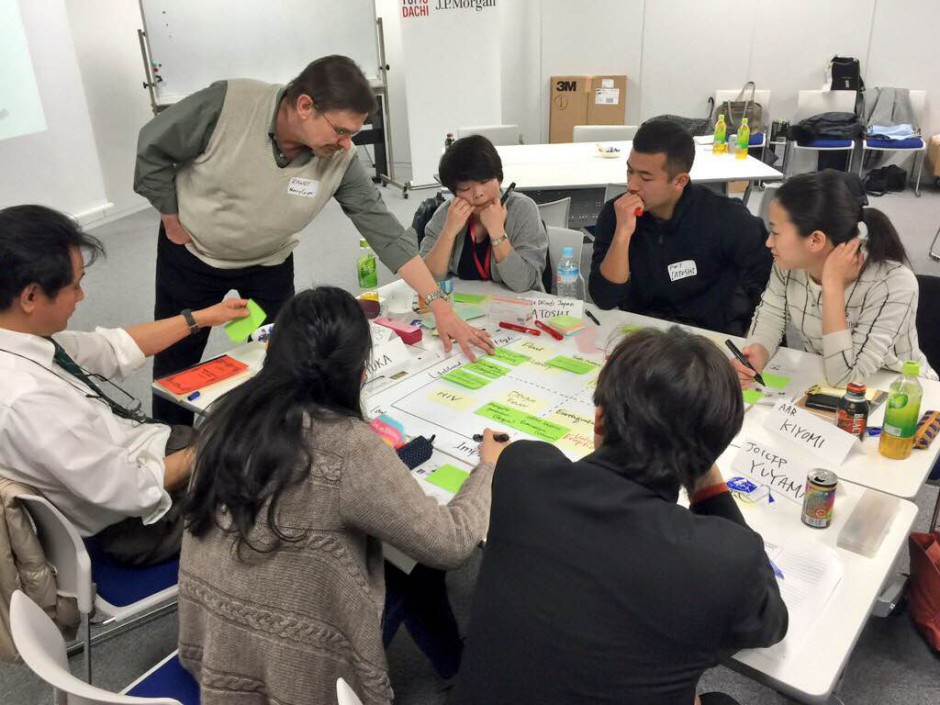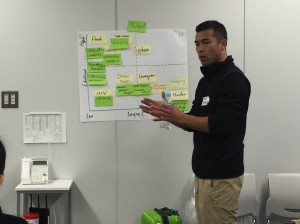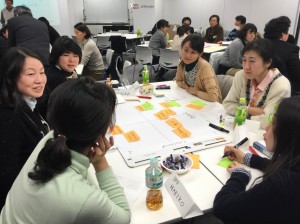Japanese NGO Leaders Learn Key Security Concepts and Planning Tools To Mitigate Risk and Reduce Threats on Overseas Humanitarian Missions

How do you protect yourself and your staffers in challenging security environments?
What policies and procedures does your organization have in place to reduce risk in those regions?
On February 26, 2015, over 30 Japanese NGO leaders who work in potentially dangerous areas and regions gathered at the Security Workshop held under the TOMODACHI NGO Leadership Program supported by J.P. Morgan to take a closer look at these pertinent questions and learn about how to better prepare to reduce these risks.
 The workshop was organized by JAPAN PLATFORM and led by Randy Martin of Mercy Corps who discussed core concepts of the security of humanitarian aid workers, shared his best practices and most memorable learning opportunities, and encouraged participants to share their experiences in the field. The goal was for participants to identity threats, see the need for better security policies and producers, and be able to envision how they might apply these core NGO security concepts and planning tools to their organization’s strategy and policies. Yu Tsukioka, Programme Coordinator of the Overseas Programme Division at JAPAN PLATFORM, said that he had come to learn how to create a new policy manual on security measures for his organization, especially before May when he plans to head out to Jordan to help with humanitarian efforts in Syria and Iraq.
The workshop was organized by JAPAN PLATFORM and led by Randy Martin of Mercy Corps who discussed core concepts of the security of humanitarian aid workers, shared his best practices and most memorable learning opportunities, and encouraged participants to share their experiences in the field. The goal was for participants to identity threats, see the need for better security policies and producers, and be able to envision how they might apply these core NGO security concepts and planning tools to their organization’s strategy and policies. Yu Tsukioka, Programme Coordinator of the Overseas Programme Division at JAPAN PLATFORM, said that he had come to learn how to create a new policy manual on security measures for his organization, especially before May when he plans to head out to Jordan to help with humanitarian efforts in Syria and Iraq.
An excerpt from the Workshop Description reads: “NGOs operate in increasingly challenging security environments. NGOs, as humanitarian organizations, have unique ways of enhancing security that are distinct from those used by police and military institutions.” During the workshop, participants learned that acceptance by the community, reducing vulnerability through the creation of proper tools and mechanisms for protection, and identifying strategies that offer a counter-threat are the core elements in creating a more secure environment. In short, Mr. Martin summarized these concepts under three points as the need to have good programs, good management, and a good network on the ground.
Following Randy Martin’s talk, a group activity portion grouped participants into counties they had worked (or plan to work in): the Philippines (in response to Typhoon Haiyan), South Sudan (to help during wartime efforts), and Jordan (to support the increasing need for humanitarian aid from the war in Syria and Iraq). The groups conducted a risk analysis of their respective counties by identifying primary threats and went on to create a security strategy by discussing ways to reduce the threat and in turn the vulnerability to that threat.
The four-hour workshop concluded with suggested readings and sample manuals such as the Good Practice Review: Operational Security Management in Violent Environments by the Humanitarian Practice Network (published December 2010), the ECHO Security Guide for Humanitarian Organizations by the European Community Humanitarian Office, European Commission (published in 2004), and the Mercy Corps Field Security Manual that the NGOs were welcome to use as a starting point in creating their own policies and procedures for security.
 Afterwards, the participants reflected on the importance of this workshop. Chisa Watanabe, Program Officer at JEN (Japan Emergency NGO), trains new hires for her organization and has a new view of the importance of having refresher courses for the staff – especially before they go on projects overseas in response to the need for humanitarian aid. Anna Tamaki, Project Coordinator at BHN Association, focuses on disaster response communications by providing radio communication capabilities in affected areas. She has worked in the Tohoku region and most recently in Bangladesh. Anna came to this workshop to learn about how she might be able to better judge the risks and threats in a situation for herself, and now sees the importance of creating policies or standardized procedures for her other staffers going to high risk areas around the world.
Afterwards, the participants reflected on the importance of this workshop. Chisa Watanabe, Program Officer at JEN (Japan Emergency NGO), trains new hires for her organization and has a new view of the importance of having refresher courses for the staff – especially before they go on projects overseas in response to the need for humanitarian aid. Anna Tamaki, Project Coordinator at BHN Association, focuses on disaster response communications by providing radio communication capabilities in affected areas. She has worked in the Tohoku region and most recently in Bangladesh. Anna came to this workshop to learn about how she might be able to better judge the risks and threats in a situation for herself, and now sees the importance of creating policies or standardized procedures for her other staffers going to high risk areas around the world.


